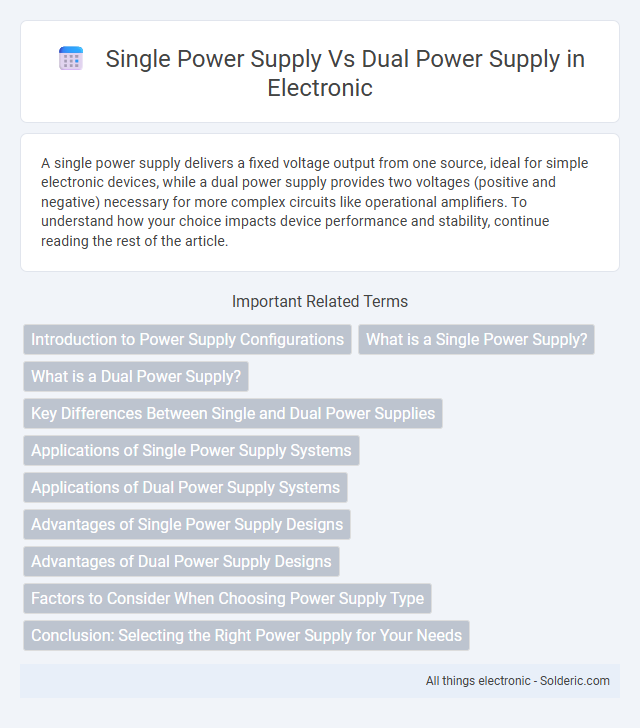A single power supply delivers a fixed voltage output from one source, ideal for simple electronic devices, while a dual power supply provides two voltages (positive and negative) necessary for more complex circuits like operational amplifiers. To understand how your choice impacts device performance and stability, continue reading the rest of the article.
Comparison Table
| Feature | Single Power Supply | Dual Power Supply |
|---|---|---|
| Voltage Output | One fixed voltage (e.g., +12V) | Two voltages, usually positive and negative (e.g., +12V, -12V) |
| Application | Simple circuits, basic DC devices | Operational amplifiers, analog circuits needing bipolar voltages |
| Complexity | Lower complexity, easier to design | Higher complexity, requires careful balancing |
| Cost | Generally lower cost | Typically higher cost due to additional components |
| Size | Compact size | Larger size due to dual rails |
| Ground Reference | Single ground reference | Center-tapped ground for dual reference |
| Common Usage | Digital circuits, simple sensors | Audio equipment, analog signal processing |
Introduction to Power Supply Configurations
Single power supply systems provide a single voltage output, typically referenced to ground, making them common in simpler electronic circuits and devices. Dual power supply configurations offer both positive and negative voltages relative to a common ground, essential for analog circuits requiring symmetrical voltage rails, such as operational amplifiers. Understanding the differences in voltage outputs, reference points, and application requirements is crucial for selecting the appropriate power supply configuration in electronic circuit design.
What is a Single Power Supply?
A single power supply provides electrical power through one voltage source, typically delivering either a positive or negative voltage relative to ground. Commonly used in simple electronic circuits, it simplifies design by offering a single rail for voltage output. This type of power supply is ideal for applications that do not require bipolar voltages or symmetrical power rails.
What is a Dual Power Supply?
A dual power supply provides two voltage outputs, typically positive and negative, allowing devices to operate efficiently with balanced power sources. This configuration is essential for circuits like operational amplifiers where symmetrical voltage rails improve performance and reduce noise. Your selection depends on the specific grounding and voltage requirements of your electronic device.
Key Differences Between Single and Dual Power Supplies
Single power supplies provide a single voltage output, typically positive or negative, suitable for basic electronic devices and circuits. Dual power supplies deliver both positive and negative voltage outputs, essential for powering operational amplifiers and analog circuits requiring symmetrical voltages. Your choice between single and dual power supplies depends on the voltage requirements and complexity of your electronic system.
Applications of Single Power Supply Systems
Single power supply systems are widely used in consumer electronics, such as smartphones, laptops, and LED lighting, where space efficiency and cost reduction are critical. These systems simplify circuit design by providing a single voltage rail, making them ideal for low-power applications like microcontrollers and sensors. Industrial automation and automotive electronics also benefit from single power supplies due to their compactness and ease of integration.
Applications of Dual Power Supply Systems
Dual power supply systems are essential in applications requiring both positive and negative voltage rails, such as analog signal processing, operational amplifiers, and audio equipment, where symmetrical power enhances performance and minimizes distortion. These systems improve reliability and noise reduction in sensitive instrumentation and communication devices by providing stable bipolar voltages. Industries including telecommunications, medical devices, and industrial automation rely on dual power supplies to ensure precise and efficient operation of their electronic circuits.
Advantages of Single Power Supply Designs
Single power supply designs offer simpler circuit configurations and reduced component counts, resulting in lower cost and enhanced reliability for electronic devices. They eliminate the need for multiple voltage rails, which simplifies power management and mitigates issues related to voltage imbalance or ground loops. Single power supplies are commonly used in battery-operated devices and compact systems where space efficiency and ease of integration are critical.
Advantages of Dual Power Supply Designs
Dual power supply designs offer enhanced reliability and redundancy, ensuring continuous operation even if one power source fails. These systems provide improved voltage regulation and noise reduction by separating positive and negative voltage rails, which is critical for sensitive electronics. Your devices benefit from increased stability and precision, making dual power supplies ideal for applications requiring consistent and clean power delivery.
Factors to Consider When Choosing Power Supply Type
Choosing between a single power supply and a dual power supply depends on factors such as voltage requirements, load stability, and noise tolerance. Single power supplies offer simplicity and cost-effectiveness for applications with steady voltage and current demands. Your decision should consider the need for multiple voltage rails, improved noise isolation, or redundancy, which dual power supplies provide for complex or sensitive electronics.
Conclusion: Selecting the Right Power Supply for Your Needs
Choosing between a single power supply and a dual power supply depends on the specific requirements of your electronic device or system. Single power supplies offer simplicity and cost-effectiveness, making them ideal for less complex circuits with stable voltage needs. Dual power supplies provide both positive and negative voltages, essential for analog devices and operational amplifiers that require symmetrical power to function correctly.
single power supply vs dual power supply Infographic

 solderic.com
solderic.com